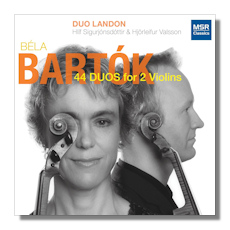
The Internet's Premier Classical Music Source
Related Links
- Bartók Reviews
- Latest Reviews
- More Reviews
-
By Composer
-
Collections
DVD & Blu-ray
Books
Concert Reviews
Articles/Interviews
Software
Audio
Search Amazon
Recommended Links
Site News
 CD Review
CD Review
Summary for the Busy Executive: Mini-Bartók – a shot of espresso.
Some composers thrive on limitations. Stravinsky waxed lyrical on constriction in The Poetics of Music since it cuts down on the confusing infinity of being able to do anything and reveals a clearer path. Few composers were so economical with their notes. Ravel loved staying within the conventions of whatever genre he found himself, and the master of orchestral lushness in Daphnis et Chloé also turned out the Chansons madécasses for voice, flute, cello, and piano as well as the Sonata for Violin and Cello. Something about this spareness aesthetically satisfies me. Not coincidentally, the original version of Siegfried-Idyl for thirteen players remains my favorite Wagner.
Bartók as a composer had no use for padding. Every note does what I'd call heavy lifting. However, he also sought other limitations. We find in his output the magnificent Sonata for Solo Violin, the 2- and 3-Part Choruses for trebles, the progressive volumes of Mikrokosmos, and these 44 Duos for 2 Violins. Like the Choruses and the Mikrokosmos, the 44 Duos have a pedagogical function. Bartók arranged the last into four volumes, with each piece slightly more difficult than the previous one. However, the duos go beyond this, becoming little haikus of folk material in highly sophisticated, even advanced, musical settings. Few of these pieces exceed a minute-and-a-half, and many run less than a minute. One of the signs of a master miniaturist is that the material seems neither too big nor too small for its frame. I find Liadov, for example, often lacking in that regard; sometimes an unsuccessful Liadov miniature poops out or never gets going while at others you sense he could have said a lot more. With Bartók, each little piece satisfies, no matter how long it takes.
If you think about it, the traps of a violin duo become obvious: two instruments with the same tone and range. The composer must find some way to distinguish the two voices and to avoid general congestion. Bartók, who absorbed counterpoint into his composing bones from early in his career, overcomes these caveats without apparently a conscious thought. However, beyond its technical brilliance, the counterpoint never intrudes as such. Rather, it adds to either the excitement of a dance or the poignance of a song.
The packaging of this score has misled many to treat it as a course of study – although created by a genius, obviously. Many recordings seem to plow their way dutifully through each little etude, note-perfect but dry. Often, they present the work in its published order, each piece a gradus ad Parnassum. However, Bartók himself didn't see the duos in that way and even suggested a performance order. I've not heard anybody before Duo Landon to actually follow that order (although others have recorded the score in a sequence they themselves have devised), and I must say it makes a difference to me. Duo Landon (Hilf Sigurjónsdóttir and Hjörleifur Valsson), from Iceland (they take their name from their instrument maker), both have the notes well in hand. Sigurjónsdóttir and Valsson are well matched in their tone, with (I assume; whoever's coming out of my left channel most of the time) Sigurjónsdóttir slightly brighter. Debussy once remarked that music was what happened between the notes. The duo goes deep into those spaces, turning each miniature into a poem, as concentrated and high-energy as a haiku. They impress me as having spent a lot of time living with each one. Epiphanies abound. They do both versions of "Bagpipes" (nos. 36a and b) as well as two performances of "Mosquito Dance" (no. 22), the first straight and the second a run with so much buzzing and Doppler effect that you may find yourself swatting at something that isn't actually there. I consider this the best recording by far of all the others I've heard.
Copyright © 2014, Steve Schwartz





















